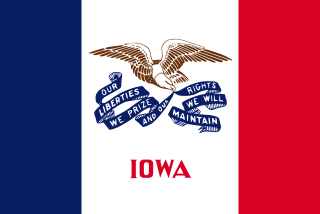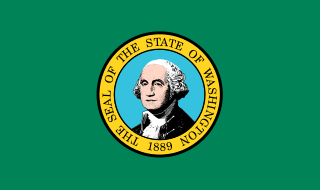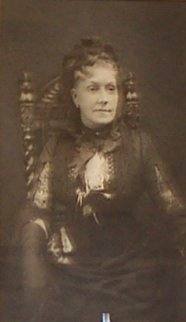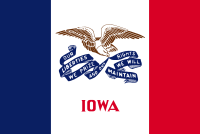
Knoxville is a city and county seat of Marion County, Iowa, United States. The population was 7,595 at the time of the 2020 census, an increase from 7,313 in the 2010 census. Knoxville is home of the National Sprint Car Hall of Fame & Museum, located next to the famous Knoxville Raceway dirt track.

Richard Andrew Gephardt is an American attorney, lobbyist, and politician who represented Missouri's 3rd congressional district in the United States House of Representatives from 1977 to 2005. A member of the Democratic Party, he was House majority leader from 1989 to 1995 and minority leader from 1995 to 2003. He ran unsuccessfully for the Democratic nomination for President of the United States in 1988 and 2004. Gephardt was mentioned as a possible vice presidential nominee in 1988, 1992, 2000, 2004, and 2008.

The National Society Daughters of the American Revolution is a lineage-based membership service organization for women who are directly descended from a person involved in supporting the American Revolution. A non-profit group, the organization promotes education and patriotism. Its membership is limited to direct lineal descendants of soldiers or others of the American Revolution era who aided the revolution and its subsequent war. Applicants must be at least 18 years of age and have a birth certificate indicating that their gender is female. DAR has over 190,000 current members in the United States and other countries. The organization's motto is "God, Home, and Country".

The flag of the state of Iowa is a vertical tricolor flag designed by Dixie Cornell Gebhardt in 1917. Iowa, United States legislators officially adopted the flag in 1921.

The flag of Washington consists of the state seal, displaying an image of its namesake George Washington, on a field of dark green with gold fringe being optional. It is the only U.S. state flag with a field of green as well as the only state flag with the image of an American president. The secretary of state regulates flag protocol related to the state flag, as well approving replica flags for commercial sale and other standards related to the flag.

The flag of Wyoming was officially adopted to represent the U.S. state of Wyoming on January 31, 1917. The flag consists of the silhouette of an American bison. The red symbolizes the Native Americans and the blood of pioneers who gave their lives. The white is a symbol of purity and uprightness. The blue is the color of the skies and distant mountains. It is also a symbol of fidelity, justice and virility. The bison represents the local fauna, while the seal on it suggests the custom of branding livestock.
The Iowa State Council for Defense was created by Iowa Governor William L. Harding one month after the United States entered World War I, and was disbanded soon after the end of the war. It became a focal point of various political battles conducted in the name of loyalty and Americanism.

The Great Seal of the State of Illinois is the official emblem of the U.S. state, and signifies the official nature of a document produced by the state of Illinois. The flag of the state of Illinois consists of the seal of Illinois on a white background, with the word "Illinois" underneath the seal. The present seal was adopted in 1869, the flag bearing the central elements of the seal was adopted in 1915, and the word Illinois was added to the flag in 1970. In a 2001 survey by the North American Vexillological Association, the flag of Illinois was ranked 49th out of 72 different flags of states and territories, mainly in the US and Canada.
Gebhardt is a German surname. Notable people with the surname include:
Helena Rebecca Hellwig Pouch was an American female tennis player and served as the 18th President General of the Daughters of the American Revolution.

The Marion County Courthouse in Knoxville, Iowa, United States was built in 1896. It was listed on the National Register of Historic Places in 1981 as a part of the County Courthouses in Iowa Thematic Resource. The courthouse is the third building the county has used for court functions and county administration.

Mary Boyce Temple was an American philanthropist and socialite, active primarily in Knoxville, Tennessee, in the late 19th and early 20th centuries. She was the first president of the Ossoli Circle, the oldest federated women's club in the South, and published a biography of the club's namesake, Margaret Fuller Ossoli, in 1886. She also cofounded the Tennessee Woman's Press and Author's Club, the Knoxville Writer's Club, and the Knox County chapter of the League of Women Voters. She represented Tennessee at various international events, including the Paris Exposition of 1900 and at the dedication of the Panama Canal in 1903.

Catharine H. T. Avery was an American author, editor, and educator of the long nineteenth century. Of Revolutionary ancestry and hailing from Michigan, she was founder and regent of the Western Reserve Chapter of the Daughters of the American Revolution (DAR), of Cleveland, Ohio; Vice-president General of its National Society; and editor of the National Society's official organ, the American Monthly. She also served two years as a member of the Cleveland School Board, being the first woman in Ohio chosen to an elective office.

Denise Doring VanBuren is an American civil leader and clubwoman. She was the 45th President General of the National Society Daughters of the American Revolution from 2019 to 2022.
Wilhelmena Rhodes Kelly was an African-American genealogist who traced her American lineage to the April 5, 1614, union of Pocahontas and John Rolfe. She was also a member of the Jamestowne Society. In 2019 she became the New York State Regent and a member of the National Board of Management, highest ranking woman of color in the National Society Daughters of the American Revolution (NSDAR), since its founding in 1890. She was a pioneer of African-American genealogy. Born and raised in Brooklyn, she was a local Brooklyn historian and member of the Society of Old Brooklynites (SOB), one of the borough's oldest civic organizations. She was the author of books on Bedford-Stuyvesant as well as the Crown Heights and Weeksville sections of Brooklyn, and family genealogy books tracing her family's American roots.

Lynn Forney Young is an American civil leader and clubwoman. She was the 43rd President General of the Daughters of the American Revolution, serving from 2013 to 2016. As the organization's president general, she oversaw a $4 million restoration of DAR Constitution Hall, led the organization in setting a Guinness World Record for "most letters to military personnel collected in one month" with 100,904 letters to members of the United States Armed Forces, and met with Elizabeth II during an event to launch a project to digitilize the Royal Archives of George III.

Ida Soule Kuhn was a social and political activist from Hoquiam, Washington. Kuhn was an honorary member of and occupied managerial positions in a number of famous American social organizations. An activist and speaker, she publicly expressed her pro-American political beliefs during World Wars I and II.

Ella Park Lawrence was an avid advocate for, and is still known today as the “mother” of the Illinois State Flag. She was the Regent of the Rebecca Park chapter of the Daughters of the American Revolution (DAR), State Regent of the DAR organizations in Illinois, as well as a known leader and philanthropist of her community, Galesburg, Illinois.

Abby Day Slocomb was an American inventor, philanthropist and historic preservationist. Born and raised in New Orleans, Louisiana, she descended from a Connecticut Revolutionary soldier and was a Quaker. After marrying Cuthbert H. Slocomb in 1860, she served as a nurse during the American Civil War. Her husband was a Confederate officer and the cannon used by his unit was named "Lady Slocomb" in her honor. He died in 1873, leaving his share of the lucrative hardware firm, Slocomb, Baldwin & Company, to his wife and sister, Ida A. Richardson. In addition to her earnings from the business, Slocomb filed several patents. She donated windows to the historic Christ Church Cathedral in New Orleans and helped the Ladies Aid Society raise money to save the church.
Pamela Hilda Edwards Rouse Wright is an American philanthropist, clubwoman, businesswoman, and jewelry designer. Since 2022, she has served as the President General of the National Society Daughters of the American Revolution. She is the second Texan to serve as the national society's president general.


















